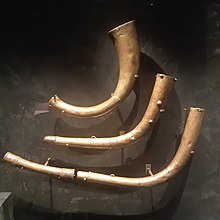| Dowris Hoard | |
|---|---|
 Image of the hoard in the National Museum of Ireland Image of the hoard in the National Museum of Ireland | |
| Material | Bronze |
| Created | 900–600 BC |
| Present location | British Museum, London; National Museum of Ireland, Dublin |
The Dowris Hoard is the name of an important Bronze Age hoard of over 200 objects found in Dowris, County Offaly, Ireland. Items from the deposit are currently split between two institutions: the National Museum of Ireland in Dublin and the British Museum in London.
The hoard mostly of objects in bronze, was probably a ritual deposit, perhaps for religious purposes, though the records of the discovery, by farm labourers in the 1820s, do not allow to be sure if it was one deposit, or a series. Current thinking tends to see it as a series, possibly over a very long period, of ritual deposits into a lake.
The importance of the hoard in Irish prehistory has led to the naming of the final phase of the Irish Late Bronze Age (900–600 BC) as the Dowris Phase or period. Over time Irish prehistoric bronzesmiths had become highly adept at casting and working with sheet metal and the Dowris Phase reflects the culmination of this as well as an industrial growth in metalworking. During this period ironworking was already found on the European Continent, in Hallstatt culture "C", and arrived in Britain, but did not reach Ireland. Until the culture was apparently disrupted around 600 BC, gold jewellery of superb quality was produced, as well as weapons, tools, trumpets and other kinds of objects in bronze, of which the Dowris Hoard has an exceptional selection.
Discovery


The Dowris Hoard was accidentally discovered in the 1820s by two men digging trenches for potatoes on a peat bog near the shores of Lough Coura. During the Bronze Age, the area was covered by a shallow lake, which later silted up in the late Middle Ages. Dowris (also known as Doorosheath or Duros) is located near the village of Whigsborough, northeast of Birr in County Offaly, Ireland. The hoard subsequently came into the possession of William Parsons, 3rd Earl of Rosse and TD Cooke. The latter sold his collection of Irish antiquities to the British Museum in 1854.
Description
One of the largest Bronze Age assemblage of artefacts ever found in Ireland, the Dowris Hoard originally comprised more than 200 pieces, of which 111 are currently in the collections of the National Museum of Ireland and 79 in the British Museum. In total, the hoard includes:
- 44 spearheads
- 48 crotals (a musical instrument in the form of a rattle)
- 43 socketed axes
- 26 bronze horns or trumpets
- 5 swords (approx 48 cm long, possibly originating from the south of England)
- A riveted bronze cauldron
- Three buckets or situlae
- Numerous tools including chisels and knives.
The hoard contains all but two of the Bronze Age crotals (Greek 'crotalon' – castanet or rattle) ever found, the other two also being Irish (but see also crotal bell for later types). These are bronze cylinders in the rough shape of a bull's testicle, with a piece of baked clay or a pebble inside. It is presumed they functioned as a type of rattle, perhaps "in the rites of a fertility cult associated with the bull, echoes of which may survive in the early medieval tale Táin Bó Cúailnge (The Cattle Raid of Cooley)". The hoard had 48 of them in total, in two sizes.
See also
Notes
- "National Museum of Ireland website". Archived from the original on 23 October 2015. Retrieved 2 November 2014.
- British Museum Collection
- Wallace, 90–91
- "Mooghaun Hoard", A History of Ireland in 100 Objects, An Post, The Irish Times, National Museum of Ireland and the Royal Irish Academy, 2017
- Wallace, 86–93
- Full list from British Museum:"The hoard included five swords; chape, purse-shaped; one spearhead, lunate-shaped openings in the wings; 34 spearheads, plain leaf-shaped; 35 axes (G. Eogan, The Socketed Bronze Axes in Ireland, Prehistorische Bronzefunde IX, 22 (2000) nos. 88, 303–305, 363–365, 377, 409, 500, 596, 597, 776–784, 1154–1157, 1259, 1260, 1379, 1564, 1565, 1626–1630, 1704); socketed hammer; four socketed gouges, three socketed knives; four tanged knives; three razors (A. Jockenhövel, Die Raisermesser in Westeuropa, Prehistorische Bronzefunde VIII, 3 (1980), Nr. 190, 191, 195); bucket (S. Gerloff, Atlantic Cauldrons and Buckets, Prehistorische Bronzefunde II, 15, no. 95); base of bucket (Gerloff, Prehistorische Bronzefunde II, 15, no. 102); two angle plates from base of bucket, probably insular type (Gerloff, Prehistorische Bronzefunde II, 15, no. 103); cauldron (Gerloff, Prehistorische Bronzefunde II, 15, no. 12); fragments of two cauldrons (Gerloff, Prehistorische Bronzefunde II, 15, nos. 20 a. b; 43); seven horns, end blow; nine horns, side blow; 48 crotals; tube with expanded circular foot; object with round bulbous head and somewhat triangular shaped blade; part of flat axe; three pieces of hollow "bronze" tube; two lumps of waste bronze; six sandstone pieces." BM Collection Database
- British Museum Highlights
- Wallace, 86–93, 91 quoted
References
- G. Eogan: The Hoards of the Irish later Bronze Age. Dublin, 1983; pp. 69–73.
- Wallace, Patrick F., O'Floinn, Raghnall, eds. Treasures of the National Museum of Ireland: Irish Antiquities, Dublin: Gill & Macmillan, 2003 ISBN 0717128296